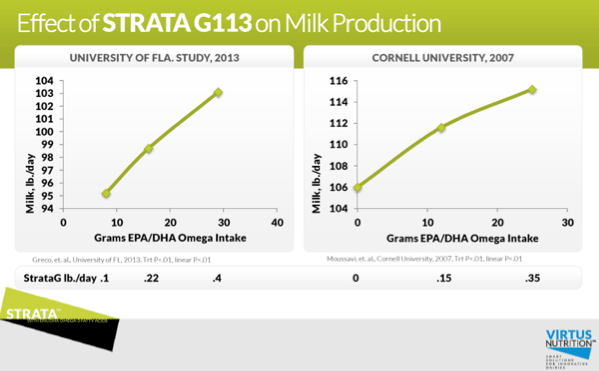
 Confirming research from the University of Florida has for the first time definitively quantified the clear linear milk response to the grams of EPA/DHA omega-3 fatty acids fed to early lactation dairy cattle. Dr. Jose Santos from the University of Florida-Gainesville presented his research group's findings, which validate and extend earlier Cornell University research, at the annual ADSA (American Dairy Science Association) meetings this summer in Indianapolis, Indiana.
Confirming research from the University of Florida has for the first time definitively quantified the clear linear milk response to the grams of EPA/DHA omega-3 fatty acids fed to early lactation dairy cattle. Dr. Jose Santos from the University of Florida-Gainesville presented his research group's findings, which validate and extend earlier Cornell University research, at the annual ADSA (American Dairy Science Association) meetings this summer in Indianapolis, Indiana. "Our research clearly shows that manipulating the omega-6 and omega-3 fatty acids in the diet influence lactation performance and fertility," Santos stressed. "Simply replacing omega-6s with the omega-3s from fish oils resulted in greater yields of milk and milk components and improved pregnancy per AI."
In his most recent study, Santos altered the ratio of omega-6 to omega-3 fatty acids by feeding varying levels of Strata with EPA/DHA omega-3s (manufactured by Virtus Nutrition) in the diets of early lactation cows, while keeping energy across treatments the same. Cows fed the lowest ratio of omega-6s to omega-3s (4:1 ratio) produced more milk than the other two ratios tested. Feeding rates of Strata with EPA/DHA omega-3s and corresponding fat corrected milk responses were the following: .1 lbs. of Strata yielded 95.5 lbs. of FCM; .22 lbs. yielded 99.9 lbs. of FCM, and .4 lbs. of Strata yielded 105.6 lbs. of FCM. The difference between the .1 lb. and .4 lb. feeding rates was 7.5 lbs. of milk and 10.1 lbs. of fat corrected milk.
"Cows fed the highest amount (4/10th lb.) consumed 3 lbs. more dry matter/day, which accounts for a portion of the increase in fat-corrected milk yield," explained Santos.
Nevertheless, there were 3 lbs of fat-corrected milk response that could not be accounted for by the increased DM intake. Santos and his colleagues believe this is a direct effect of the specific dietary fatty acids.
Santos said their research also showed that "adding calcium salts of these required fatty acids in early lactation rations to balance for lower ratios of omega-6 to omega-3 fatty acids, directly influences embryo quality and pregnancy rates, as well as milk production."
"Cows fed moderate amounts of omega-6s and omega-3s at this stage had improved embryo quality and increased pregnancy, 30% to 37%," said Santos. "In another experiment, pregnancy loss was reduced from 12% to 6%. So, we think essential fatty acids and some of the long chain polyunsaturated fatty acids found in marine oils are not only affecting milk production and reproduction, but the cow's health as a whole."
This 2013 research data developed by Santos' group also goes further in validating specific 2007 Cornell University data that shows a linear correlation to varying levels of EPA/DHA omega-3s, with more than 9 pounds of milk at the highest feeding rate of .35 pounds of Strata G113.

"We've known about the milk response to EPA/DHA Omega-3s for quite some time," said Dr. Kevin Murphy, Technical Director for Virtus Nutrition, "but the work done by Santos certainly adds tremendous credence to the linear nature of the response we see both in the research and on dairies."
10.03.2013